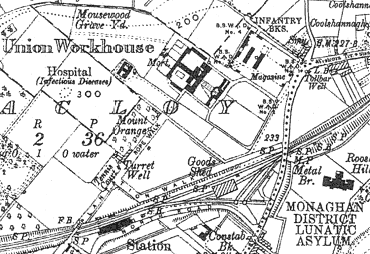Monaghan, Co. Monaghan
Monaghan Poor Law Union was formally declared on the 4th November 1839 and covered an area of 175 square miles. Its operation was overseen by an elected Board of Guardians, 27 in number, representing its 21 electoral divisions as listed below (figures in brackets indicate numbers of Guardians if more than one):
Co. Monaghan: Anketell Grove, Bellanode, Caddagh, Castleshane, Clones, Clontibret, Derrygola, Drumhillagh (2), Drumsnat, Emyvale, Figullar, Glaslough (2), Killylough, Kilmore, Monaghan (3), Rackwallace, Scots Town (2), Sheskin, Tedavnet, Tehallan, Tullycorbet (2).
The Board also included 9 ex-officio Guardians, making a total of 36. The Guardians met each week on Monday.
The population falling within the Union at the 1831 census had been 69,137 with divisions ranging in size from Killylough (population 1,770) to Monaghan itself (7,954).
The new Monaghan Union workhouse was erected on an eight-acre site at the north of Monaghan. Designed by the Poor Law Commissioners' architect George Wilkinson, the building was based on one of his standard plans to accommodate 900 inmates. Its construction cost £6,350 plus £1,457 for fittings etc. The workhouse was declared fit for the reception of paupers on 25th April 1842 and admitted its first inmates on 25th May.
The workhouse location and layout are shown on the 1909 map below.

Monaghan workhouse site, 1909.
The buildings followed Wilkinson's typical layout. An entrance and administrative block at the east contained a porter's room and waiting room at the centre with the Guardians' board room on the first floor above.
The main accommodation block had the Master's quarters at the centre, with male and female wings to each side. At the rear, a range of single-storey utility rooms such as bakehouse and washhouse connected through to the infirmary and idiots' wards via a central spine containing the chapel and dining-hall. A mortuary lay behind the infirmary, with a graveyard nearby.
During the famine in the mid-1840s, additional accommodation was erected for an additional 300 inmates. Premises were hired to hold 30 fever patient. A fever hospital was subsequently erected at the west of the workhouse.
At the 1901 census, the population of the Union was 32,414 with 12 officials and 144 inmates in the workhouse.
The Monaghan workhouse, together with the other three in the county, was closed on 1 April 1921. The fever hospital was taken over by the nearby County Asylum in 1945. The other workhouse buildings no longer exist.
Records
Note: many repositories impose a closure period of up to 100 years for records identifying individuals. Before travelling a long distance, always check that the records you want to consult will be available.
- Clones Branch Library, 98 Avenue, Clones, Co Monaghan. Holdings include Guardians' minutes and correspondence c.1840-1933.
Bibliography
- The Workhouses of Ulster by Michael H Gould (1983, Ulster Architectural Heritage Society).
- The Workhouses of Ireland by John O'Connor (Anvil Books, 1995)
Links
- None.
Unless otherwise indicated, this page () is copyright Peter Higginbotham. Contents may not be reproduced without permission.


